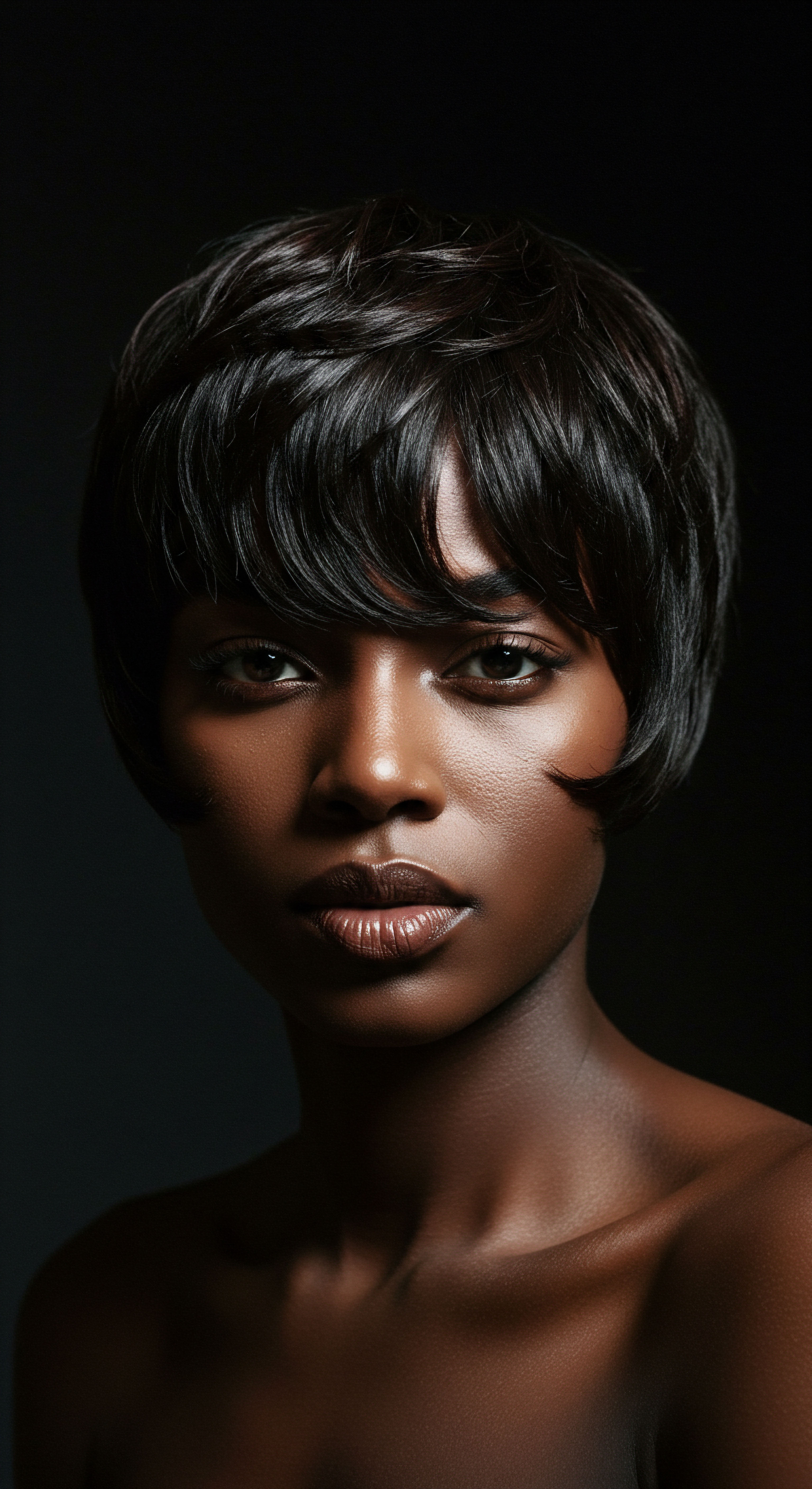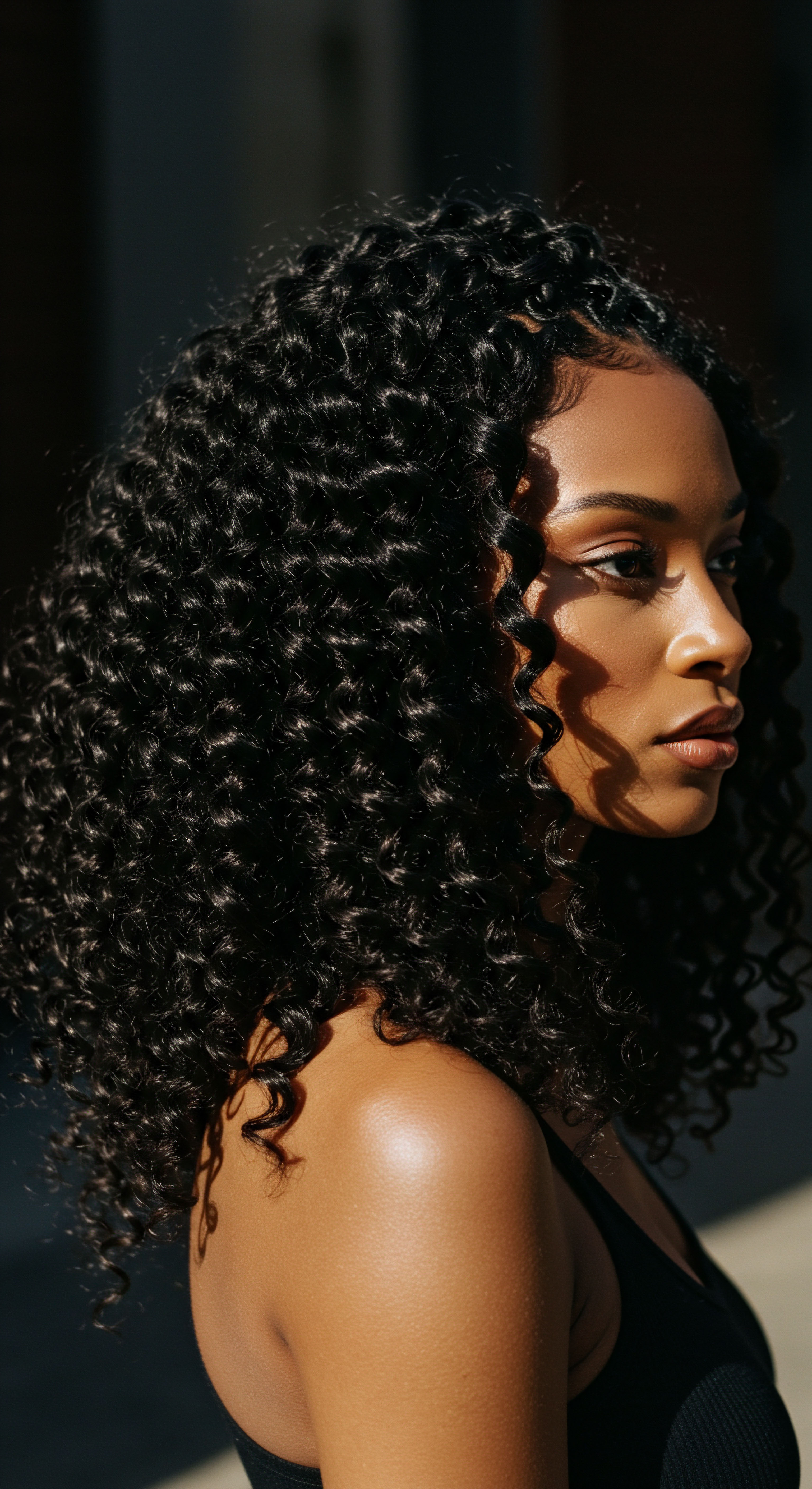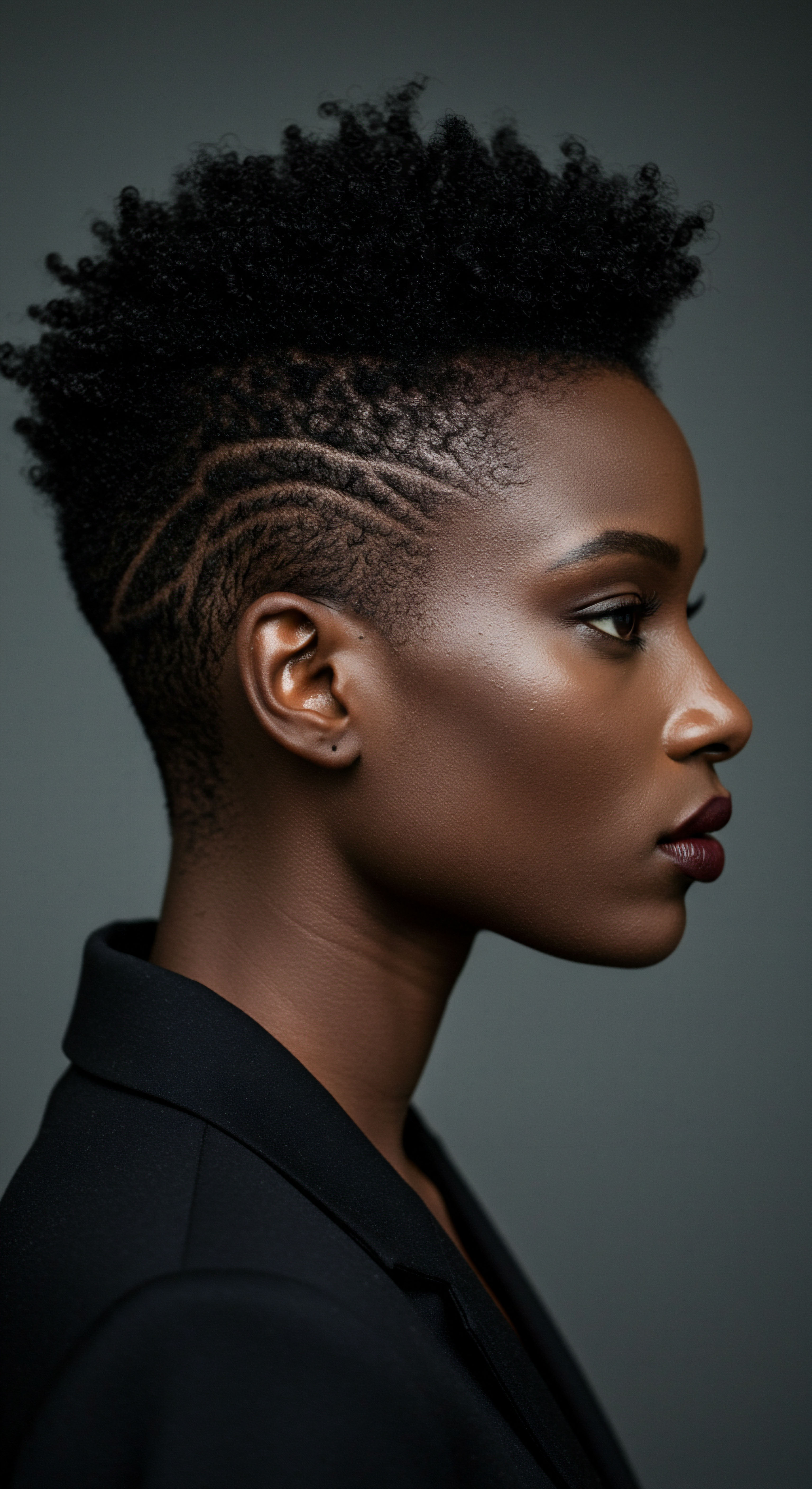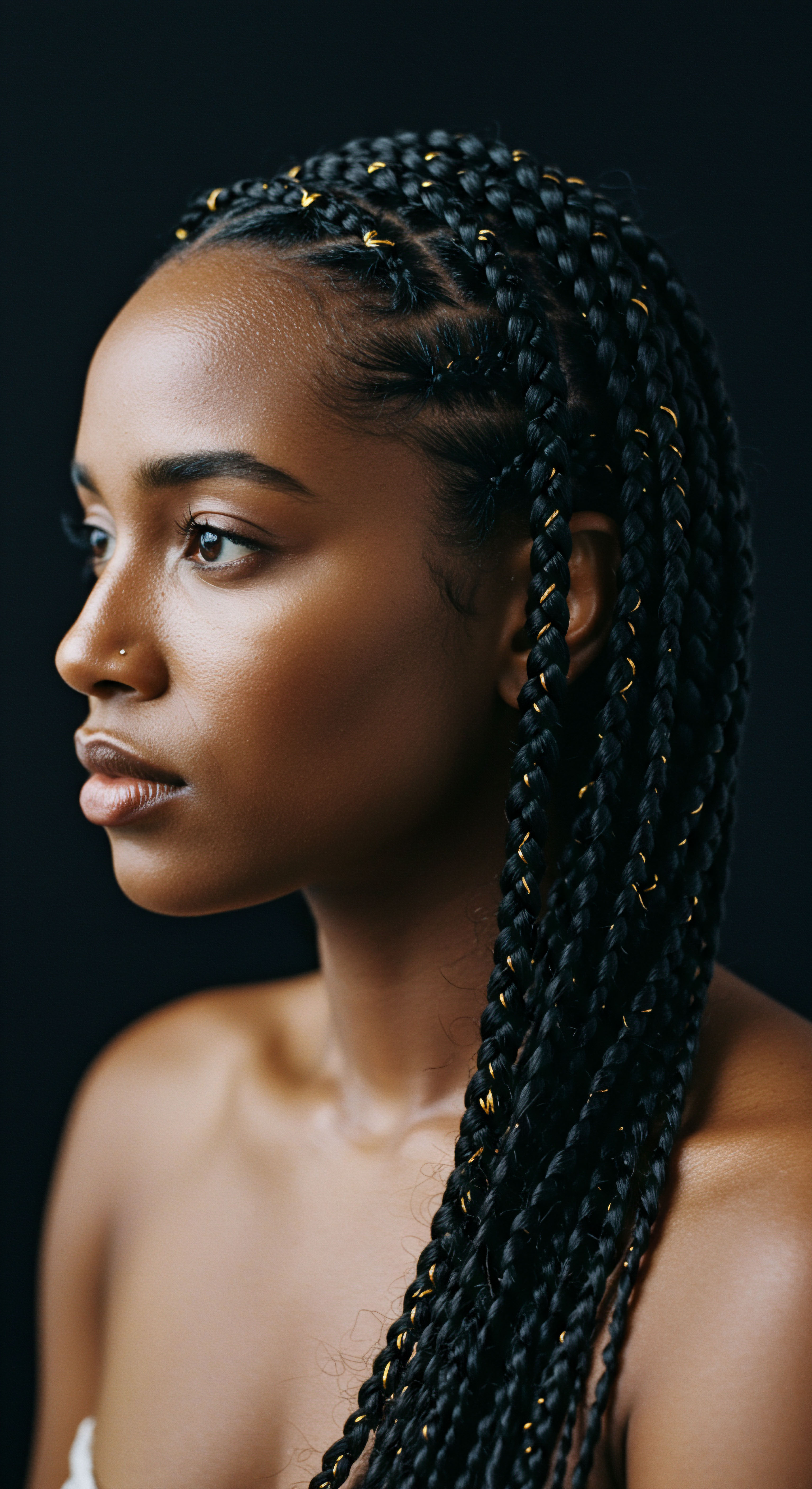
Roots
A gentle inquiry into the strands that shape us often begins not with what we see, but with what we feel, deeply, within the quiet spaces of our being. The touch of a brush, the scent of a botanical oil, the rhythmic parting of coils – these are not merely actions upon the hair itself. They are often whispers from a long-held knowing, an echo of traditions that bind us to something larger than our individual experience.
For many with textured hair, this daily engagement can be a passage, a quiet rediscovery of connections that might have frayed or seemed distant. It is a moment where the physical act of care can become a deep dialogue with heritage, an unearthing of identity that extends beyond personal preference.
The physical structure of textured hair itself, in its magnificent diversity, holds within it a story. Each curl, coil, and wave relates a tale of genetic legacy, of environmental adaptation, and of the unique demands placed upon it. Comprehending this foundational biology is the first step in developing a care regimen that does more than simply manage; it respects. This initial understanding provides a grounding presence, allowing us to move from mere observation to informed, gentle interaction with our hair.

The Intricacy of Textured Hair Biology
To truly value textured hair, one must look beyond its outward appearance and consider its microscopic architecture. Unlike straight hair, which typically grows from a round follicle, textured hair emerges from an oval or elliptical follicle. This shape causes the hair shaft to grow in a helical, or spiral, pattern. The more pronounced the ovality of the follicle, the tighter the curl or coil of the hair strand.
This anatomical distinction gives rise to the characteristic bends and twists that define textured hair, simultaneously contributing to its strength and its particular vulnerabilities. The very shape of the follicle determines how the hair fiber is formed, impacting its overall strength and resilience.
The cuticle, the outermost layer of the hair shaft, consists of overlapping scales. In straight hair, these scales lie relatively flat, creating a smooth surface. With textured hair, the cuticle scales often lift more at the curves and bends of the strand. This slight elevation, while contributing to the hair’s visual depth and light play, also means textured hair can be more susceptible to moisture loss and friction-induced damage.
The internal structure, the cortex, composed of keratin proteins, also exhibits variations in its distribution, influencing the hair’s elasticity and overall resilience. This complex arrangement demands a specific approach to hydration and handling.
The very architecture of textured hair whispers tales of its distinct needs and vulnerabilities, a biological narrative intertwined with each strand.

How Do Follicle Shapes Affect Hair Health?
The unique geometry of the hair follicle dictates not only the curl pattern but also influences how sebum, the natural oil produced by the scalp, travels down the hair shaft. For straight hair, sebum can easily coat the entire strand, providing natural lubrication and protection from root to tip. However, with the twists and turns of textured hair, sebum often struggles to descend past the initial few inches from the scalp, leaving the mid-lengths and ends more prone to dryness. This inherent tendency towards dryness necessitates a more intentional approach to hydration and sealing moisture into the hair, ensuring every part of the strand receives adequate care.
Furthermore, the points where the hair shaft bends most sharply are areas of structural weakness. These ‘points of least resistance’ are more susceptible to breakage from mechanical stress, whether from styling, manipulation, or even environmental factors such as wind or harsh sun. This biological reality underscores the significant importance of gentle handling, the thoughtful selection of protective styles, and a care regimen focused on minimizing friction and maximizing hydration. Understanding these foundational biological principles allows for a proactive and respectful approach to hair care, moving beyond superficial concerns to address the hair’s inherent needs with informed kindness.
| Hair Type Straight Hair |
| Follicle Shape Round |
| Cuticle Behavior Lies flat |
| Sebum Distribution Evenly coats shaft |
| Hair Type Textured Hair |
| Follicle Shape Oval or Elliptical |
| Cuticle Behavior Tends to lift at bends |
| Sebum Distribution Limited travel down shaft |
| Hair Type These fundamental differences shape the distinct care requirements for textured hair. |

Decoding Textured Hair Classification Systems
The various classification systems for textured hair serve as helpful guides, offering a common vocabulary to describe the vast spectrum of curl patterns. While no system perfectly encapsulates the individual uniqueness of every head of hair, they provide a starting point for understanding general characteristics and predicting how hair might behave. The most widely recognized system, often attributed to Andre Walker, categorizes hair into types 1 through 4, with sub-classifications (A, B, C) denoting increasing tightness of curl or coil within each type. This framework aids in product selection and styling approaches, offering a general roadmap for care.
- Type 1 ❉ Straight hair, without any noticeable curl or wave.
- Type 2 ❉ Wavy hair, characterized by a gentle S-shape, ranging from loose waves to more defined ones.
- Type 3 ❉ Curly hair, with distinct loops and spirals that form a clear curl pattern, often with volume.
- Type 4 ❉ Coily hair, characterized by tight, often Z-patterned coils that can appear dense and have significant shrinkage.
Within Type 3 and Type 4, the A, B, C distinctions indicate the circumference of the curl or coil. For instance, 3A might describe loose, large curls, while 4C represents very tight, often zigzag coils that are prone to significant shrinkage. While these classifications are useful for general product selection and styling guidance, they are not rigid boundaries.
Many individuals possess multiple curl patterns on their heads, creating a complex and beautiful array of textures. This individual variation highlights the need for personalized care that goes beyond broad categorization.

Beyond Classification The Feel of Hair
Beyond visual classification, understanding hair involves its inherent qualities such as porosity and density. Porosity refers to the hair’s ability to absorb and retain moisture. High porosity hair has a more open cuticle layer, allowing moisture to enter and exit easily, often leading to dryness and a need for heavier, sealing products.
Low porosity hair has a tightly bound cuticle, making it harder for moisture to penetrate but once absorbed, it retains it well, often benefiting from lighter, penetrating products. Understanding one’s hair porosity is a remarkably significant aspect of selecting appropriate products and care techniques, as it directly impacts hydration.
Density refers to the number of individual hair strands on one’s head. High-density hair appears thick and full, while low-density hair may appear thinner and might require products that offer volume without weighing it down. This attribute influences how products are distributed and the overall volume and body of a style.
Recognizing these internal characteristics, alongside external curl patterns, offers a more complete portrait of one’s hair, enabling a more precise and respectful approach to its care. This foundational knowledge presents a lens through which hair care becomes less about external standards and more about intimate understanding of one’s unique strands.

Ritual
Stepping from the thorough understanding of hair’s very structure, we arrive at the practices that bring this knowledge to life. The daily or weekly rhythms of hair care are far more than mere chores; they are deliberate acts, often imbued with personal significance and cultural memory. Each application of conditioner, every gentle detangling session, and the mindful creation of a protective style can serve as a reaffirmation, a tangible connection to a lineage of care and adornment. This section moves us into the realm of action, where understanding meets application, and where routines can become deeply restorative experiences.
The act of caring for textured hair, with its specific needs and unique properties, can be a quiet, yet powerful, declaration of self-acceptance and cultural continuity. It is in these consistent, mindful practices that the deeper implications of hair care truly reveal themselves, offering a quiet solace and a sense of belonging.

The Art of Protective Styling
Protective styles act as a shield for textured hair, minimizing manipulation and exposure to environmental stressors such as harsh winds, sun, or dry air. These styles tuck away the delicate ends of the hair, which are the oldest and most fragile parts of the strand, thus reducing breakage and promoting length retention. From classic braids to twists and buns, the range of protective options is vast, each offering distinct aesthetic and practical benefits tailored to different hair types and preferences. They offer a reprieve from daily styling and can be worn for extended periods.
- Braids ❉ Classic three-strand braids, cornrows, box braids, and knotless braids offer versatility and longevity. They secure the hair in neat sections, significantly reducing tangling and friction, and can be adorned in countless ways.
- Twists ❉ Two-strand twists, flat twists, and Senegalese twists provide a softer, often lighter alternative to braids, allowing for greater access to the scalp for moisturizing and product application.
- Buns and Updos ❉ Simple, elegant options that keep hair off the shoulders and neck, preventing friction with clothing and surfaces, which often leads to breakage for delicate ends.
The choice of a protective style often extends beyond practical considerations. It can be a statement of personal style, a nod to ancestral practices, or a way to honor the versatility of textured hair. The deliberate act of creating these styles, often a time-consuming process, can itself be a meditative ritual, a period of quiet focus and self-attunement. This time spent in care can be a quiet act of defiance against pressures to conform, a celebration of one’s inherent beauty.

How Can Styling Reinforce Cultural Identity?
For many, hair is a direct link to heritage, and styling traditions carry deep cultural weight. Examine the complex patterns of cornrows, which have been documented in African cultures for thousands of years, serving as indicators of age, marital status, wealth, and tribal identity. The act of braiding or twisting hair, often passed down through generations, becomes a living archive of these practices. It is a tangible link to forebears who also adorned their hair with care and intention, a continuation of a silent, powerful dialogue across time.
A study published in the Journal of Black Psychology highlighted the connection between hair practices and racial identity development among Black women, finding that adopting natural hair styles correlated with increased racial identity salience and collective self-esteem. This suggests that the choices made in hair care and styling are not isolated aesthetic decisions; they are deeply intertwined with self-perception and a sense of belonging to a broader cultural group. The very act of choosing a style that honors one’s natural texture, or a style rooted in cultural tradition, can be a quiet yet significant affirmation of identity in a world that often pressures conformity, thereby alleviating feelings of cultural disconnection.
Hair care rituals, far from being mere vanity, serve as quiet yet powerful acts of cultural continuity and personal reaffirmation.

Tools of the Trade and Their Purpose
The right tools are essential for gentle and effective textured hair care. Detangling, in particular, requires implements designed to minimize breakage and preserve the hair’s natural curl pattern. Wide-tooth combs, detangling brushes with flexible bristles, and even fingers are preferred over fine-tooth combs that can snag and damage delicate strands. The appropriate tool can make the difference between a frustrating, damaging session and a smooth, gentle one.
Beyond detangling, other tools serve specific purposes. Spray bottles filled with water or leave-in conditioner aid in rehydrating hair between wash days, refreshing curls and making product application more even. Satin or silk scarves and pillowcases reduce friction, preventing frizz and breakage during sleep, thereby protecting the hair’s moisture balance.
Hair picks, while often associated with volume, also gently lift roots without disrupting curl patterns, allowing for a light, airy finish. The deliberate selection and use of these tools transform the act of hair care into a precise and thoughtful process, respecting the hair’s integrity and promoting its overall health.
| Tool Wide-Tooth Comb |
| Primary Purpose Detangling |
| Benefit for Textured Hair Minimizes breakage, preserves curl pattern |
| Tool Satin/Silk Scarf |
| Primary Purpose Sleep Protection |
| Benefit for Textured Hair Reduces friction, retains moisture |
| Tool Spray Bottle |
| Primary Purpose Rehydration |
| Benefit for Textured Hair Refreshes curls, aids product distribution |
| Tool Selecting appropriate tools is paramount for maintaining the vitality and health of textured hair. |

The Thoughtful Approach to Heat
While embracing natural texture is often a goal, heat styling remains a part of many hair care routines, offering versatility and different aesthetic outcomes. The key to its careful use lies in understanding the potential for damage and implementing rigorous protective measures. Excessive or improper heat can permanently alter the hair’s protein structure, leading to loss of curl pattern, dryness, and breakage that is difficult to reverse. This can compromise the long-term health of the hair.
When applying heat, whether from a blow dryer, flat iron, or curling wand, the guiding principle is moderation and protection. Using a heat protectant spray is non-negotiable, as it creates a barrier between the hair shaft and the heat source, minimizing direct thermal impact. Opting for lower temperature settings, minimizing the number of passes over each section, and ensuring hair is thoroughly dry before applying direct heat are all essential steps.
The goal is to achieve the desired style without compromising the long-term health and integrity of the hair. This balanced approach acknowledges both the desire for styling freedom and the inherent fragility of textured strands, ensuring that versatility does not come at the cost of well-being.

Relay
Having considered the foundational biology and the practical applications of hair care, we now step into a more deep inquiry ❉ how do these seemingly individual acts of hair care connect us to wider currents of culture, history, and collective identity? The daily motions of cleansing, conditioning, and styling are not isolated gestures; they are often echoes of generational wisdom, silent dialogues with societal expectations, and powerful affirmations of selfhood in a world that often seeks to define us. This segment examines the complex interplay of biological reality, psychological well-being, and socio-cultural forces that shape our relationship with our hair, particularly for those with textured strands.
Here, we seek to comprehend the deeper currents, the unspoken connections, and the quiet acts of resilience that can be found within the very routines we practice, moving beyond the visible to the deeply felt.

The Nighttime Sanctuary Essential Sleep Protection and Bonnet Wisdom
The hours of sleep, often overlooked in daily hair care discussions, are remarkably important for textured hair health. During sleep, hair is susceptible to friction against pillows and bedding, which can lead to tangles, frizz, and breakage. Cotton pillowcases, with their absorbent nature, can also draw moisture from the hair, exacerbating dryness and leaving strands parched. This makes nighttime protection not merely a suggestion, but a fundamental aspect of preserving hair integrity and moisture balance, safeguarding the efforts of daytime care.
The silk or satin bonnet, head wrap, or pillowcase functions as a quiet guardian in this nightly ritual. These materials possess a smooth surface that reduces friction, allowing hair to glide without snagging or pulling, thus preventing mechanical damage. Their non-absorbent properties help to retain the hair’s natural oils and applied moisture, ensuring that the efforts of the day’s conditioning are not undone by the night.
This simple, yet effective, practice contributes significantly to reducing frizz, preventing knots, and maintaining curl definition, ultimately leading to healthier, more manageable hair over time. It transforms the act of sleeping into a period of gentle restoration for the hair, allowing it to rejuvenate.

Can Hair Rituals Offer Psychological Anchors?
The connection between hair and mental well-being is a rich field of inquiry. For many, hair care routines serve as a consistent, comforting anchor in a world that can feel unpredictable and demanding. The repetitive motions of applying product, the sensory experience of a gentle scalp massage, and the tangible results of healthy hair can contribute to a sense of control and accomplishment.
This is particularly true for individuals whose hair has historically been a site of societal judgment or misunderstanding, where external pressures have often dictated acceptable appearance. Reclaiming agency over one’s hair care can be a significant act of self-care and resistance, a quiet assertion of personal autonomy.
A study by Sarah L. Webb and Carla D. Hunter in the Journal of Counseling Psychology explored the psychological benefits of natural hair adoption among Black women, finding that the process often involved a shift towards greater self-acceptance and a challenge to Eurocentric beauty standards.
The researchers posited that the physical act of caring for natural hair, and the social support found within natural hair communities, contributed to a strengthened sense of identity and reduced internalized racism. This highlights how personal hair care routines can extend beyond the physical, touching upon deep psychological benefits related to identity formation and resilience, acting as a powerful buffer against cultural disconnection.
Beyond physical upkeep, hair care routines can serve as quiet anchors, grounding individuals in self-acceptance and cultural affirmation amidst external pressures.

Ingredient Insights for Textured Hair
Understanding the ingredients in hair products is paramount for crafting an effective and beneficial regimen for textured hair. Certain components are particularly advantageous, while others may be detrimental. Humectants, such as glycerin and hyaluronic acid, attract moisture from the air into the hair, providing essential hydration, especially in humid climates.
Emollients, like shea butter, coconut oil, and argan oil, soften and smooth the hair, reducing friction and enhancing pliability, making detangling easier. Proteins, such as keratin and wheat protein, can help to strengthen the hair shaft, particularly for strands that have experienced damage from chemical processes or heat.
Conversely, certain ingredients should be approached with caution. Heavy silicones, while providing temporary shine, can build up on the hair, leading to dryness and dullness over time, forming a barrier that prevents moisture from entering. Sulfates, common in many shampoos, can be overly stripping for textured hair, removing too much of the hair’s natural oils and leaving it feeling dry and brittle. Alcohol, particularly drying alcohols like ethanol, can dehydrate the hair, making it prone to breakage.
A discerning eye for ingredient lists allows individuals to select products that genuinely nourish and support their hair’s unique structure, rather than simply masking issues. This conscious selection process is a form of informed self-advocacy, aligning product choices with hair health goals.
| Ingredient Category Humectants |
| Examples Glycerin, Hyaluronic Acid |
| Benefit/Caution Attracts moisture to hair |
| Ingredient Category Emollients |
| Examples Shea Butter, Argan Oil |
| Benefit/Caution Softens, adds pliability |
| Ingredient Category Proteins |
| Examples Keratin, Wheat Protein |
| Benefit/Caution Strengthens hair structure |
| Ingredient Category Heavy Silicones |
| Examples Dimethicone, Cyclopentasiloxane |
| Benefit/Caution Can cause buildup, dryness (caution) |
| Ingredient Category Sulfates |
| Examples Sodium Lauryl Sulfate |
| Benefit/Caution Can be overly stripping (caution) |
| Ingredient Category Careful ingredient selection is essential for optimal textured hair health. |

Addressing Common Textured Hair Concerns
Textured hair, with its unique characteristics, often presents specific concerns that require targeted approaches. Dryness, as discussed, is a primary challenge due to the difficulty of sebum distribution along the coiled strand. This can be mitigated through consistent deep conditioning treatments, the regular use of leave-in conditioners, and sealing with oils to lock in moisture. Breakage, particularly at the points where the hair shaft bends most sharply, necessitates gentle detangling techniques, the consistent use of protective styling, and minimizing chemical or heat damage that compromises hair integrity.
Shrinkage, the apparent reduction in length when textured hair dries, is a natural phenomenon for many curl patterns. While it can be frustrating for those seeking length, it is also a sign of healthy elasticity, indicating the hair’s ability to revert to its natural state. Strategies to minimize shrinkage include stretching techniques during drying or styling, though it is often a matter of accepting and celebrating the hair’s natural propensity.
Frizz, often a result of dryness and cuticle lifting, can be managed with proper hydration, humectant-rich products, and gentle handling that respects the hair’s delicate outer layer. Addressing these concerns thoughtfully allows individuals to move beyond frustration towards a deeper appreciation for their hair’s natural state, fostering a more positive relationship with their strands.
Targeted solutions for common textured hair concerns move beyond mere problem-solving, fostering a deeper appreciation for the hair’s natural qualities.

Holistic Influences on Hair Vitality
The vitality of hair extends beyond topical products and styling techniques; it is deeply intertwined with overall well-being. Diet plays a significant role, as hair is composed primarily of protein. A diet rich in lean proteins, healthy fats (like omega-3 fatty acids), vitamins (especially biotin, vitamins A, C, D, E), and minerals (iron, zinc) provides the necessary building blocks for strong, healthy hair growth from within. Hydration, through sufficient water intake, is also essential for maintaining the hair’s pliability and preventing dryness, ensuring that the body’s internal environment supports hair health.
Stress, often underestimated, can have a tangible impact on hair health, potentially leading to increased shedding or slower growth by disrupting the hair growth cycle. Managing stress through practices like mindfulness, adequate sleep, and regular physical activity can contribute to a healthier scalp environment and more robust hair. Furthermore, the very act of engaging in a mindful hair care routine can itself be a stress-reducing practice, offering moments of calm and self-connection amidst the demands of daily life. This perspective views hair not as an isolated entity, but as a reflection of the body’s broader state of health and balance, emphasizing the interconnectedness of internal and external care.

Reflection
As our contemplation of textured hair care concludes, we are left with a quiet realization ❉ the acts of tending to our strands are rarely just about aesthetics. They are often deep engagements with self, with memory, and with the currents of cultural belonging. From the microscopic architecture of a single coil to the shared rituals passed through generations, hair care offers a silent language, a means of connecting to something elemental within us and something enduring beyond us. It is in the gentle touch, the informed choice, and the quiet moments of care that we might find not only solace for our hair but also a deeper sense of home within ourselves and our heritage, thereby alleviating feelings of cultural disconnection.
The passage of hair care, then, is a continuous revealing, a testament to the quiet strength held within our daily practices. It is a reminder that the most significant connections are often found in the most intimate, consistent gestures of care, allowing us to carry our past into our present with grace.

References
- Webb, S. L. & Hunter, C. D. (2014). The Natural Hair Movement ❉ An Exploration of Identity, Self-Esteem, and Collective Action Among Black Women. Journal of Black Psychology, 40(3), 223-247.
- Byrd, A. & Tharps, L. (2014). Hair Story ❉ Untangling the Roots of Black Hair in America. St. Martin’s Press.
- Banks, I. (2000). Hair Matters ❉ Beauty, Power, and Black Women’s Consciousness. New York University Press.
- Gage, A. (2012). The Science of Hair Care. CRC Press.
- Mercer, K. (1994). Welcome to the Jungle ❉ New Positions in Black Cultural Studies. Routledge.
- Sherrow, V. (2006). Encyclopedia of Hair ❉ A Cultural History. Greenwood Press.
- Branch, E. M. (2009). Hair. In Africana ❉ The Encyclopedia of the African and African American Experience (2nd ed.). Oxford University Press.